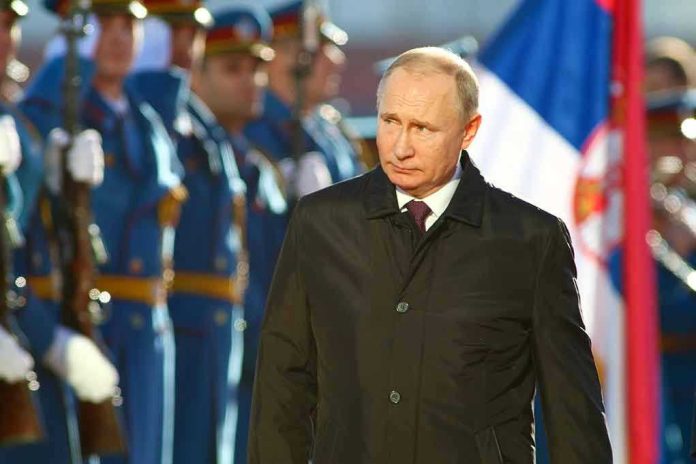
When Poland unveiled a downed Russian Shahed drone and warned that Putin could strike deep into Europe, the message was clear: the war’s front lines may be shifting, and the next target could be anywhere west of Ukraine.
Story Snapshot
- Poland warns that Russian aggression could spill far beyond Ukraine’s borders, putting all of Europe at risk.
- The unveiling of a downed Shahed drone signals Russia’s evolving drone warfare tactics and Iranian involvement.
- Leaked intelligence suggests the Kremlin may be planning an invasion of Poland by 2027, raising NATO’s alert.
- Emergency NATO consultations and intensified defense measures are underway to counter new threats.
Poland’s Stark Warning: Putin’s Threat Looms Over Europe
Poland’s political leadership wasted no words in its recent warnings. Foreign Minister Radosław Sikorski, standing before a packed parliament, declared that Putin’s expansionist ambitions would not rule over any Eastern European capital again. The message was more than rhetorical flourish; it was a calculated signal to NATO and the EU that the era of strategic ambiguity is over. The speech marked a turning point in European security thinking, as leaked Kremlin documents soon revealed invasion plans targeting Poland by 2027, igniting alarm in allied capitals.
Poland’s proximity to Ukraine has made it a frontline state since Russia’s full-scale invasion in 2022. Polish airspace has been violated repeatedly by Russian drones and missiles, each incident prompting emergency consultations with NATO. The most recent breach—featuring a Russian Shahed drone, recovered and paraded before the press in October 2025—was not an isolated technical mishap. It was emblematic of Russia’s evolving drone warfare, using Iranian-made technology to probe and pressure the alliance’s eastern flank.
Unveiling of Shahed Drone: A Shift in Russian Tactics
The Shahed drone, long associated with Iranian proxy warfare in the Middle East, has become Russia’s tool of choice for asymmetric attacks on Ukraine and, increasingly, Polish territory. Poland’s decision to publicly unveil the downed drone was as much about deterrence as transparency. The move sent a message to European partners: the threat is not hypothetical, it is present and material. Military analysts argue that Shahed drones are cost-effective, expendable, and capable of sowing confusion and fear deep behind the front lines. Their appearance in Polish airspace escalates the stakes, pushing NATO to refine its drone defense doctrines and invest in layered air defenses.
Poland’s Prime Minister Donald Tusk reinforced this urgency during an August 2025 address, asserting that Russia cannot emerge stronger from the war, and that Ukraine’s security is inseparable from Europe’s own stability. The revelation of drone incursions dovetailed with intelligence leaks—allegedly from Ukrainian and Western sources—indicating the Kremlin’s intent to expand military operations westward unless decisively deterred. The unveiling of the Shahed drone punctuated these warnings, shifting the narrative from speculation to hard evidence.
NATO’s Response: Reinforcing the Eastern Flank
Repeated violations of Polish airspace and the unveiling of the Shahed drone triggered emergency NATO consultations. The alliance’s Secretary General reiterated the commitment to defend “every inch” of member territory, a phrase that has become both reassurance and rallying cry. Member states bordering Ukraine and Russia increased military readiness, conducting joint exercises and deploying additional surveillance assets along their borders. The United States and European Union began coordinating enhanced aid packages for Ukraine, while quietly accelerating defense spending in Eastern Europe.
Internal debates within NATO now center on the credibility of leaked Russian invasion plans and the appropriate level of response. Some experts caution that Putin’s threats are calculated bluffs designed to deter further Western support for Ukraine. Others point to historical precedents for Russian expansionism and argue that failing to act decisively now risks emboldening future aggression. What is clear: the Shahed drone incident and Poland’s warnings have ended any illusion that the conflict will remain geographically contained.
Implications for Europe: Security, Economy, and Unity
Short-term effects are already visible. Military alert levels in Poland and neighboring states have reached highs not seen since the Cold War. Drone and missile attacks—once confined to Ukrainian battlefields—now threaten European civilians and critical infrastructure. Economically, defense budgets are swelling, and energy markets remain volatile as war-related disruptions ripple outward. Social anxiety is mounting, especially in border communities where the specter of escalation feels immediate and personal.
Long-term, Poland’s warnings may force a reckoning for European security architecture. If Russia’s threats materialize, the consequences could be profound: a broader European war, deeper NATO integration, and a strategic pivot toward militarization and resilience. Political scientists and policy experts agree on one point—Western unity and credible security guarantees for Ukraine and Poland may be the only bulwarks against further escalation. Whether Europe can sustain that unity under mounting pressure remains an open question, one with consequences that stretch far beyond Eastern Europe.
Sources:
The Independent: Ukraine war Russia Putin missile Poland
Notes from Poland: Russian cannot emerge from this war stronger warns Polish PM
The Independent: Poland Russia Ukraine war Trump Putin NATO drones
El País: Putin tests Warsaw, the EU and NATO with violation of Polish airspace







